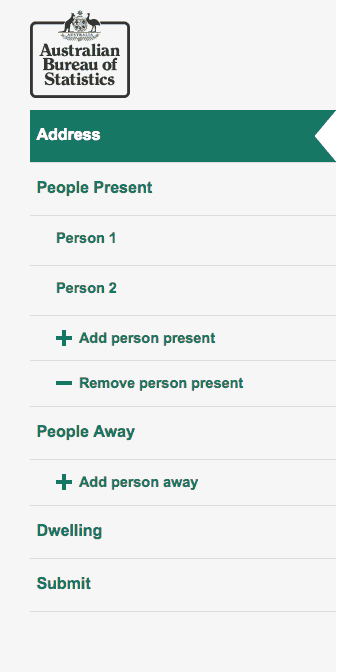Australia’s 2016 #censusfail is the talk of the nation. There are many dissatisfied users and lots of people who haven’t even been able to access the census site yet due to the reported denial of service attacks. There is much to learn from a UX perspective both in terms of process and UX design. After a bit of discussion with both friends and the team at Peak Usability I’ve put together a list of what was done well, what could have been done better, and how you can apply these learnings to your own organisation.
Understand your users

We recently did work for another government agency who are digitising a paper based survey. We distributed lengthy paper based surveys to households who then had to keep the survey for up to a week before completing it. We followed up by interviewing 24 participants to understand the end-to-end user experience of completing the lengthy survey and walked through their survey responses. Our research showed that respondents typically left the almost 2cm thick survey on their keyboard, kitchen table or other visually prominent place, which helped to remind them it needed to be completed.
In regards to the census, several people I know either A) did not recall receiving the letter with their unique code from the ABS, or B) accidentally threw it away thinking it looked like junk mail. When digitising a survey, it needs to be taken into account that the strong visual cue of a large bulky 2cm thick paper census is significantly diminished if being replaced by a single page white letter with an integral access code on it. Our recommendation to our client was to have a fieldworker distribute their survey, have a way of reminding respondents the night before the survey was to be completed, and also deliver their unique code by email or SMS if the householder had agreed. Furthermore, it would be useful for the single piece of paper to be a bright colour, and thus, easier to find.
TIP: When digitising an offline process, make sure you conduct research to understand your users and the way they typically undertake tasks. Also, assess if putting an offline process online will make sense. Perhaps the ABS could have encouraged people to do the census during the day to spread the load on the site.
User confidence & trust

Low user confidence in data security and privacy fears due to ABS process changes are likely to affect people’s willingness to complete online or do it truthfully & accurately. This has been highlighted by media reports about the ABS storing people’s names and address then linking them to other data for four years. There are also issues around people living in shared houses who may not want to share personal details, such as their income, with other housemates.
TIP: You need to build a relationship with users and gain their trust if asking them to give honest and accurate personal data.
The census included some questions that likely alienated users as no options were relevant to them.
- Marital status had no option for people involved in de-facto or same sex relationships lasting longer than 20 years.
- The gender question (against the ABS’s own recommended standard) had no online option to select if you didn’t associate with being a male or female. If you didn’t identify as male or female you were requested to phone the Census Inquiry Service (this actually accounts for around 1% of the population).
TIP: Support user’s emotive needs and don’t break their trust by alienating them if you want them to answer questions honestly.
Reasons and value propositions for users to give up their information were not always clear. People I spoke to mentioned they had not agreed to having their data made visible after 99 years as they couldn't see a good reason to do so. In the 2011 census, only 60.6% of respondents elected to have their name identified in Census information archived for future generations via the Census Time Capsule initiative. As someone who has poured over 100 year old census records, I can see the value of allowing my name to be published in 99 years but others I spoke to hadn’t even considered how the information could be useful to our future descendants.
TIP: Always make it clear why you are asking for data and provide a clear value proposition for users if you want them to agree to give up their personal data.

The image of the padlock on the home page helped communicate the census is secure (although this may be meaningless after all the media reports of the site being hacked). Not all users understand how to determine if a site is secure but pictures of padlocks help reassure the less tech savvy that a site is secure.

Flexibility and efficiency of use

On iPad, some fields wrapped e.g. option for putting in age instead of years. One person I know didn’t realise there was an option to just put age in years instead of date of birth due to field wrapping.

Poor implementation of progressive disclosure. Though the Census did acknowledge that if you are 5 years of age you are not working, it still loaded about 3 pages of questions with the text “Does not apply” and forced the user to read each page before clicking ‘Next’. There were also many questions that seemed inappropriate in relation to answers previously selected - is it really necessary to ask the marital status of my 5 year old? I am pretty sure marriage is illegal in this country at age five. It would be better to skip immediately to the next question I have to answer without showing “Does not apply” thereby eliminating more questions that are not appropriate.

No suggestive search functions. One user I know had to manually search for old postcodes on another website because there was no post code look-up function. From much collective experience, users really expect a Google type input field for questions like address where they just type a few characters and are given suggestions.

Poor translation of paper to digital and little use of in-built logic. Whilst I appreciate that the same questions need to be asked for both the digital and paper versions, digital does offer the ability to use in-built logic to provide intelligent defaults or not ask questions at all. For instance, is it really necessary to ask if any people access the internet from their dwelling when they are completing the census online? Also, I said that my husband and I were both born in Australia, so was it necessary to ask what country my two children’s parents were born in (haven’t I already told you that)?

Some questions should have been formatted as dropdown boxes instead of text input boxes as there were a limited number of choice options available, e.g. highest qualification completed (there were 15 suggested responses in the help section).
TIP: When asking for users to enter information, try to streamline the process as much as possible by:
1. Providing suggestions e.g. addresses as they type.
2. Minimising text input to reduce the amount of typing required, which is even more important for mobile user e.g. use a dropdown box for highest qualification.
3. Pre-populating fields based on earlier answers e.g. parent’s country of birth if previously provided for both parents.
4. Using progressive disclosure to only show questions relevant to the user based on previous responses e.g. don’t show the employment question or marital status for a 5 year old).

The unique 12-digit code text input boxes were separated into 3 smaller boxes with auto-tabbing (although the auto-tabbing did not appear to work on portable devices). This minimises the effort for users and makes it easier to check they have entered the correct code (as opposed to a single text input box allowing 12 characters).

The site was responsive and appears people were able to complete the questions with minimal ease on portable devices.

Ability to ‘Save and exit’ and resume later. Users were not trapped into finishing the census in one session but were able to consult with other household members who may have needed to provide data and then recommence their session once ready.

Button design was also good. A prominent green ‘Next’ button on the right and a less visually prominent grey ‘Previous’ button on the left (although I would have liked to see greater spacing between the two buttons) should have helped to guide users.

Protecting users work

Yet to be confirmed, but the census doesn’t appear to store details entered either locally or on a server unless users actively click ‘Save & Exit’. One person I know was kicked out half way through and got errors saying she couldn’t complete her census as the site was having issues.Based on the error messages provided she thought the system had not saved any of the data she had entered. As Bruce Tognazzini (ex Apple) states as a key principle of interaction design, “Users should not lose their work as a result of error on their part, the vagaries of Internet transmission, or any other reason other than the completely unavoidable…”

No apparent ability to save as you go without exiting. Though theoretically not necessary in this day & age as information can be automatically saved while users input their data, it is often good to give users the assurance that their input and work is being saved as they progress.

The ‘Save and exit’ button was placed at the top of the screen where users were not likely to click or tap this in error. From a visual flow perspective, this makes more sense than having it next to the ‘Next’ button.
Visual feedback and visibility of system status

The site did a good job of providing visual feedback of where you are in the process and how many more pages you have to complete with a clear completion status column on the left. As commented by one friend it was “easy to see where I was up to and what I still had left to do”.

Overall I think the designers at ABS have done a great job on the design of the online census form with just a few improvements that could be made. A few users I know who managed to complete it had very few issues and found the process pretty straightforward and easy. It is a significant improvement on the previous online census. The main issues, which have a dramatic effect on data quality and the user experience, are largely related to the design of the delivery & distribution process, offline support, and technical issues.
This is just quick brain dump featuring some of the good and bad UX for the census with a focus mainly on the interaction & design of the survey. I haven’t touched on the whole end-to-end user experience and emotional journey that users have and continue to go through but for many it would be something like this:
- Fear (about my privacy & data)
- Panic (when I lose code or can’t get through by phone to request a paper copy)
- Confusion (what to do now)
- Frustration (when I can’t get a hold of them by phone or access online)
- Fear (will I get a fine or was my data hacked)
- Anger (bloody typical government)
- Acceptance (stuff it, not my problem)
But that is another article for another day 😉